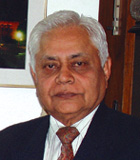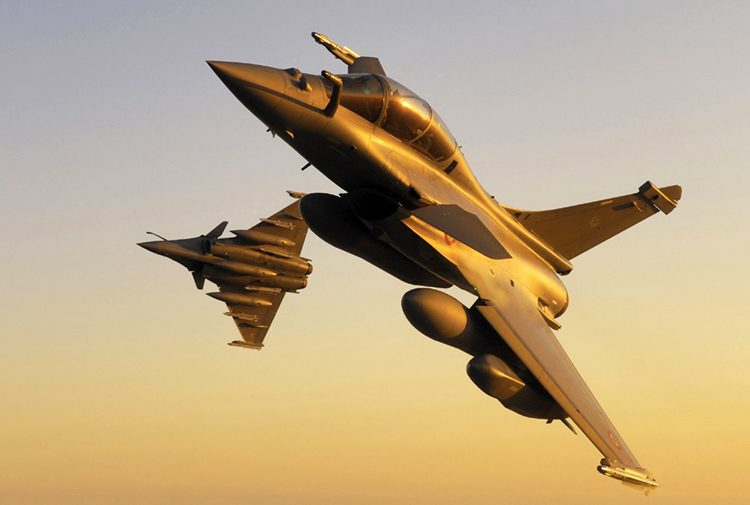INDIAN ARMED FORCES CHIEFS ON
OUR RELENTLESS AND FOCUSED PUBLISHING EFFORTS

SP Guide Publications puts forth a well compiled articulation of issues, pursuits and accomplishments of the Indian Army, over the years

I am confident that SP Guide Publications would continue to inform, inspire and influence.

My compliments to SP Guide Publications for informative and credible reportage on contemporary aerospace issues over the past six decades.
- Prime Minister witnesses 'Bharat Shakti' – a Tri-Services Firing and Manoeuvre Exercise in Pokhran, Rajasthan
- Interim Defence Budget 2024-25 — An Analysis
- Union Defence budget 2024
- Prime Minister Modi Commemorates Indian Navy Day in a Grand Ceremony
- Prime Minister Modi Flies in the LCA Tejas
- New Chapter in India-Italy Defence Ties
- Airpower beyond Boundaries
Politicising defence procurement
Through the procurement of 36 Rafale jets, the NDA government has fulfilled the mandate, at least partially, of restoring the operational potential of the combat fleet of the IAF.
 | By Air Marshal B.K. Pandey (Retd) Former Air Officer Commanding-in-Chief of Training Command, IAF |

On November 16, 2017, Rahul Gandhi, currently the Vice President of the Congress Party and soon to be its President, made allegations of wrong doing directly against Prime Minister Narendra Modi over the agreement with the Government of France to purchase 36 Rafale fighter aircraft for the Indian Air Force (IAF) through a direct government-to-government deal. A week earlier, a spokesman of the Congress Party had accused the NDA Government of compromising national security as also national interest in promoting crony capitalism by favouring Anil Ambani-led Reliance Defence Limited who is likely to benefit from this deal, not only causing heavy loss to the public exchequer, but also sacrificing the interests of the Indian defence public sector undertaking, the Hindustan Aeronautics Limited (HAL) which is a key player in the Indian aerospace industry of the nation. The Congress Party also alleged that in the deal for 36 Rafale jets, the unit cost of the aircraft was much higher than what was decided upon in the tender for 126 medium multi-role combat aircraft (MMRCA) floated in August 2007 when the UPA Government was in power. All these allegations have been negated by the party in power and Air Chief Marshal B.S. Dhanoa, Chief of the Air Staff has put at rest the questions raised by the Congress Party on technical aspects and has described it as “a very good deal”. It would be pertinent to mention here that the Rafale had already been identified by the IAF as early as in 2012 as the best option available making any fresh evaluation totally unnecessary.
Procurement of Aircraft for the IAF
Acquisition of urgently required military hardware including aircraft through direct deals with foreign governments thus obviating the need for a laborious tendering process, is nothing new for the Indian Ministry of Defence. During the days of the Cold War, military aircraft including fighter and transport aircraft as well as rotary-wing platforms were acquired in large numbers from the then Soviet Union without going through the tendering process. At one point in time, around 70 per cent of the inventory of the IAF consisted of platforms acquired through this route. More recently, during the tenure of the UPA government, the C-130J Super Hercules tactical transport aircraft and the C-17 Globemaster III strategic airlift aircraft were acquired for the IAF from the United States (US) through its Foreign Military Sales (FMS) programme, thus hastening the process of filling up critical gaps in the operational capability of the IAF without unnecessary delay.
Restoring Operational Capability of the IAF
The saga of the Rafale fighter jet began with the issue of tender for 126 MMRCA, equivalent to six squadrons, for the IAF, as the strength of the combat fleet was expected to deplete rapidly and substantially over the next few years. Also, the indigenous light combat aircraft Tejas was nowhere in sight. The need to induct a modern fourth-generation combat aircraft in large numbers into the IAF was indeed urgent for it to maintain an operational edge over the air forces of both the adversaries namely Pakistan and China. Of the six contenders in the race for the MMRCA contract, after rigorous evaluation by the IAF, only two made it to the short list. These were the Rafale from Dassault Aviation of France and the Eurofighter Typhoon from the then European Aeronautic Defence and Space Company (EADS), now renamed as Airbus Defence, Space and Security. As the Rafale was somewhat less expensive when compared to the Eurofighter Typhoon, its quote was lower and hence was declared as the preferred platform. The first 18 of the number contracted for, were to be delivered directly by the original equipment manufacturer (OEM) in flyaway condition and the remaining 108 were to be manufactured in India by HAL with Transfer of Technology (ToT). While the Indian aerospace industry in the private sector was also to be involved, the share of HAL in the project was negotiated as being more than 70 per cent. The IAF was elated at the prospect of finally inducting a large fleet of extremely potent combat platform.
The timing of the move to target Prime Minister Narendra Modi, in all likelihood, appears to be aimed at influencing the forthcoming elections in Gujarat
Unfortunately, aspirations of the IAF were shattered as the contract negotiations got bogged down over some issues that proved to be insurmountable. In the seven years that the UPA Government was responsible for this project while it was in power, the contract for 126 Rafale jets could not be finalised possibly on account of the indifferent approach of the establishment towards the erosion of the operational capability of the combat fleet of the IAF and its implications for national security. As a result, in 2014, the NDA Government inherited the MMRCA project that had actually run aground with practically no possibility of its revival. The responsibility now lay on the NDA government to fulfil the aspirations of the IAF to be able to induct modern combat aircraft to enhance its operational potential to the level required for it to be in a position to be able to successfully confront challenges looming large over the horizon.
In less than six months after assuming office, Prime Minister Narendra Modi broke the logjam with the MMRCA contract with an alternative proposal to purchase 36 Rafale jets (equivalent of two squadrons) through an Inter-Governmental Agreement (IGA). Thereafter the tender for 126 MMRCA was cancelled as it had reached a dead end. Described as a “masterstroke”, the IGA for 36 Rafale jets was duly processed in accordance with the provisions of the Defence Procurement Procedure (DPP) and the contract was signed in September 2016 by the Defence Ministers of the two nations involved. Delivery would commence three years later i.e. from September 2019 and be completed by 2022. Through the procurement of 36 Rafale jets, the NDA Government has fulfilled the mandate, at least partially, of restoring the operational potential of the combat fleet of the IAF. Integral to the agreement is the option with the Government of India to place orders for additional aircraft in the future. Action is also in hand to have a foreign OEM set up a production facility in India to manufacture in collaboration with an Indian partner a proven single-engine combat aircraft in large numbers to restore the full operational potential of the IAF.
The Final Word
Whether there is any truth in any if these allegations or not, what is notable is that the contract for 36 Rafale jets was signed more than a year ago, but there had been no comment from the Congress party till last week. The timing of the move to target Prime Minister Narendra Modi, in all likelihood, appears to be aimed at influencing the forthcoming elections in Gujarat and later in the national elections two years later. In the final analysis, it appears nothing more that blatant politicisation of defence procurement. Such political machinations would ultimately be detrimental to the effort by the IAF to upgrade operational capability in the future and in the final analysis, would impinge on national security as well. Unfortunately, such conduct will also erode the level of confidence that the IAF ought to have in the political leadership of the country who apparently are quite prepared to compromise even national security for political gains. A sad state of affairs indeed!





